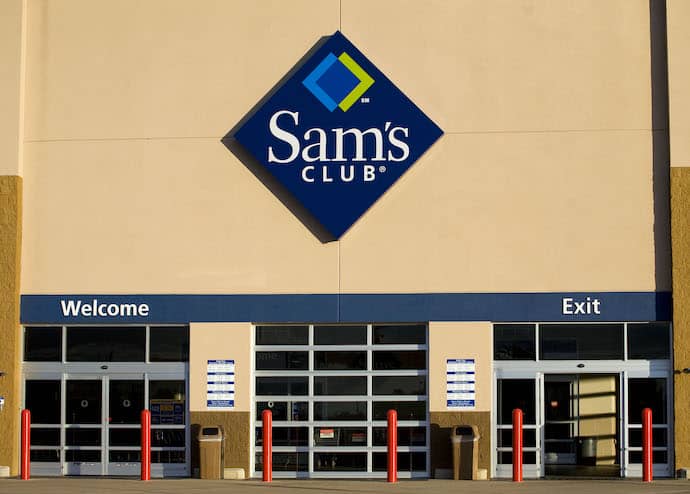Sam's Club CTO Vinod Bidarkoppa talks about changing consumer behavior during the pandemic and his organization's tech infrastructure modernization, from mainframes to the cloud.

While Sam’s Club at first glance may seem like a typical warehouse retail membership club, look beyond the pallets of packaged food and tabletops stacked with designer clothing, and you’ll see an operation committed to using technology to improve the experience of customers – or members, as they are called – and its own operations.
Case in point -- the company introduced the Scan and Go mobile phone app in 2016, allowing customers to avoid the check-out lines by using their mobile phones to scan barcodes themselves and then click a button to check out and pay.
The service made shopping more convenient for the members who used it in 2016.
But it really stood out as visionary when the pandemic hit in 2020. Scan and Go provided a contactless shopping experience at a time when the guidance on COVID was to “social distance” by staying 6 feet away from anyone else. The app allowed members to avoid close contact with anyone else at the club yet still get their shopping done.
Vinod Bidarkoppa joined the Walmart-owned Sam’s Club as CTO in February 2020, just before the pandemic really hit, and he was committed to the organization’s technology leadership. Among his priorities was to take on modernizing the company’s technology infrastructure to accommodate improvements in everything from productivity to supply chain for the organization’s almost 600 retail locations, e-commerce channel, and distribution and fulfillment centers.

Vinod Bidarkoppa, CTO, Sam's Club
Bidarkoppa recently connected with InformationWeek to talk about the pandemic, Sam’s Club’s infrastructure modernization program, and how the warehouse club is using artificial intelligence. Here are some excerpts of that conversation.
You joined Sam’s Club after a career of working in other consumer-facing businesses. Tell me about why you decided to join the company.
When I interviewed for this position, I still remember when they said, “Hey, we are a $50 billion startup.” I've never heard “$50 billion” and “startup” used in the same sentence. And I thought, this is a place that I would love to be part of.
How has the business done since you’ve joined?
Since then we've had a quite a ride. It’s a warehouse channel, which is slightly different from mass retail. Walmart isn't Sam's Club. For us it is all about membership model. People pay to shop with us, and equally we have a very curated set of items in the club, and we want to bring the best items in. It has been a phenomenal growth story for us. I mean, I think in just in the last couple of years, we've probably added more than $20 billion in just the top line, and we've grown by double digits the last 10 quarters. But what is underlying that is the significance of technology to this growth. It is evident everywhere. Technology has been the long pole in the tent for Sam's Club.
What’s driving that growth?
We look at where can technology make a difference for us. Whether it's in growing our business, driving more membership acquisition, or driving productivity all over -- in the clubs, in the DCs (distribution centers), in the FCs (fulfillment centers), it’s infused into all parts of the business … technology is so critical and fundamental as an enabler for our business growth.
Those are a lot of initiatives. How did you set the priorities?
When I came in, there was nobody in this role for almost a year, so there's a vacuum, right? First things first, what is the strategy you're trying to put in place? At Sam’s Club we have a diamond strategy, which basically is, how do we differentiate ourselves on convenience? How do we lead on price? And how do we match on quality and assortment with some of our competition that's out there?
We take that business strategy and look at where are the gaps and challenges and the technology perspective to bring that to life? That was the starting point.
Then while we're still trying to do that, the pandemic hit us right there just at the beginning of 2020. Then you go back to OK, what do you need? What do you need to do here and now, because everything changed in the span of, I would say 30 to 45 days in that March/April timeframe. Behaviors changed, right? Members all wanted to shop differently with us. We did not have some of the channels that we wanted, which are now stood up and really mature.
First things first, we said hey, how do we actually bring this new channel experiences for our members so that they can shop however they want to shop? That's when we stood up the club pick up, right, so there's a lot of energy and effort that went into standing up that channel for our members.
The other thing happening on the supply chain side was equally how do we drive productivity so that we can bunch up some of the orders. Are we bringing AI, machine learning into some of the things that we do in our [distribution centers] and [fulfillment centers]? How do we simplify our distribution center supply chain processes? Those were some of the early things that we had to tackle in order to bring shopping convenience to our members.
How does that translate into Sam’s Club’s tech infrastructure?
We started to look at the core elements of that strategy for technology investment. How do we work those initiatives to bring them to life? I divided that strategy into three buckets. One is around new member channel and revenue growth channels. The second is how we drive productivity platforms across out club associates as well as our supply chain space. The last and most important bucket for us was how do we future proof our business in that Sam's Club was started in 1983. Obviously, there are many legacy processes and many legacy systems and platforms.
And we've had phenomenal growth. When we closed this last quarter we have a record number of members since we first started. So as we're bringing these new units into the club, both online and offline, plus the phenomenal growth we saw on the ecommerce platform, we're looking at some of the legacy systems that were still in place and we said hey, we need to re-engineer this process and re-engineer these systems and sunset old legacy systems and invest in technology so that we will have the next gen systems.
Does that mean moving to the public cloud?
We are fundamentally about 80% on the public cloud. We completely rewrote our entire digital e-commerce platform, which is on the public cloud. We completely rewrote our membership platform, which was on our mainframe, and took that onto the public cloud. We offer a warehouse management system used by our supply chain and distribution center, and that was on the legacy mainframe system. We implemented a package software on the public cloud.
We are a cloud-first company. Whether it’s supply chain modernization, membership modernization, or e-commerce digital platform organization, these are all the heavy lifting we have done in the past two and a half years to get us onto a next-generation platform to help us drive not just the growth but also our productivity improvements for our club systems and supply chain systems.
What public clouds are you on?
We are across multiple clouds. We use our cloud partners to our advantage. Our goal eventually is to have a hybrid cloud platform -- a combination of private cloud and Azure public cloud as well as Google Cloud. We are balanced between those three, so we have the best of breed and best from a cost point as well.
What about AI? Can you tell me about one of the AI projects?
We have an initiative called Inventory Recognition as a Service. It’s a camera mounted scrubber, which goes around the club multiple times a day, and we capture about 17 million images every day. We label all those images, and it allows us to obviate a number of tasks that associates in the club would have had to do if not for automated task completion, which is all computer vision-based … are there discrepancies in signages and prices, are they missing, or are they out of stock. It brings all that information back so we can address them systematically.
Are these internally developed tools? Are you using a platform or open source?
These are all internally developed, custom, homegrown technology that is a combination of the great work that our product teams and the technology teams do in house. These are by and large open source, and of course we use the cloud stack, but not a packaged implementation.
Are there other pieces that were necessary for Sam’s Club to implement these modernization initiatives?
I talked about how technology is the long pole in the tent, but what makes it happen and helps us bring this to life is really the culture and organization. Member obsession is something that drives everybody…The first thing we do every Monday morning is look at the NPS (net promoter score) for all the key journeys. If the NPS has dropped, we look at what we need to do differently to help improve the member experience and the associate experience.
What to Read Next:
Walmart to Hire 5K as Tech Job Market Stays Tight
Box and MongoDB CEOs Chat About Software and the Future of Work
SAP North America’s New President Talks Reinventing for the Cloud
About the Author(s)
You May Also Like







